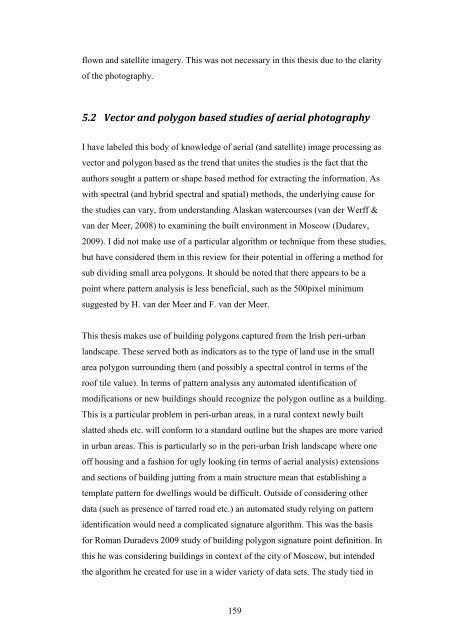Create successful ePaper yourself
Turn your PDF publications into a flip-book with our unique Google optimized e-Paper software.
flown and satellite imagery. This was not necessary in this thesis due to the clarity<br />
of the photography.<br />
5.2 Vector and polygon based studies of aerial photography<br />
I have labeled this body of knowledge of aerial (and satellite) image processing as<br />
vector and polygon based as the trend that unites the studies is the fact that the<br />
authors sought a pattern or shape based method for extracting the information. As<br />
with spectral (and hybrid spectral and spatial) methods, the underlying cause for<br />
the studies can vary, from understanding Alaskan watercourses (van der Werff &<br />
van der Meer, 2008) to examining the built environment in Moscow (Dudarev,<br />
2009). I did not make use of a particular algorithm or technique from these studies,<br />
but have considered them in this review for their potential in offering a method for<br />
sub dividing small area polygons. It should be noted that there appears to be a<br />
point where pattern analysis is less beneficial, such as the 500pixel minimum<br />
suggested by H. van der Meer and F. van der Meer.<br />
This thesis makes use of building polygons captured from the Irish peri-urban<br />
landscape. These served both as indicators as to the type of land use in the small<br />
area polygon surrounding them (and possibly a spectral control in terms of the<br />
roof tile value). In terms of pattern analysis any automated identification of<br />
modifications or new buildings should recognize the polygon outline as a building.<br />
This is a particular problem in peri-urban areas, in a rural context newly built<br />
slatted sheds etc. will conform to a standard outline but the shapes are more varied<br />
in urban areas. This is particularly so in the peri-urban Irish landscape where one<br />
off housing and a fashion for ugly looking (in terms of aerial analysis) extensions<br />
and sections of building jutting from a main structure mean that establishing a<br />
template pattern for dwellings would be difficult. Outside of considering other<br />
data (such as presence of tarred road etc.) an automated study relying on pattern<br />
identification would need a complicated signature algorithm. This was the basis<br />
for Roman Duradevs 2009 study of building polygon signature point definition. In<br />
this he was considering buildings in context of the city of Moscow, but intended<br />
the algorithm he created for use in a wider variety of data sets. The study tied in<br />
159
















